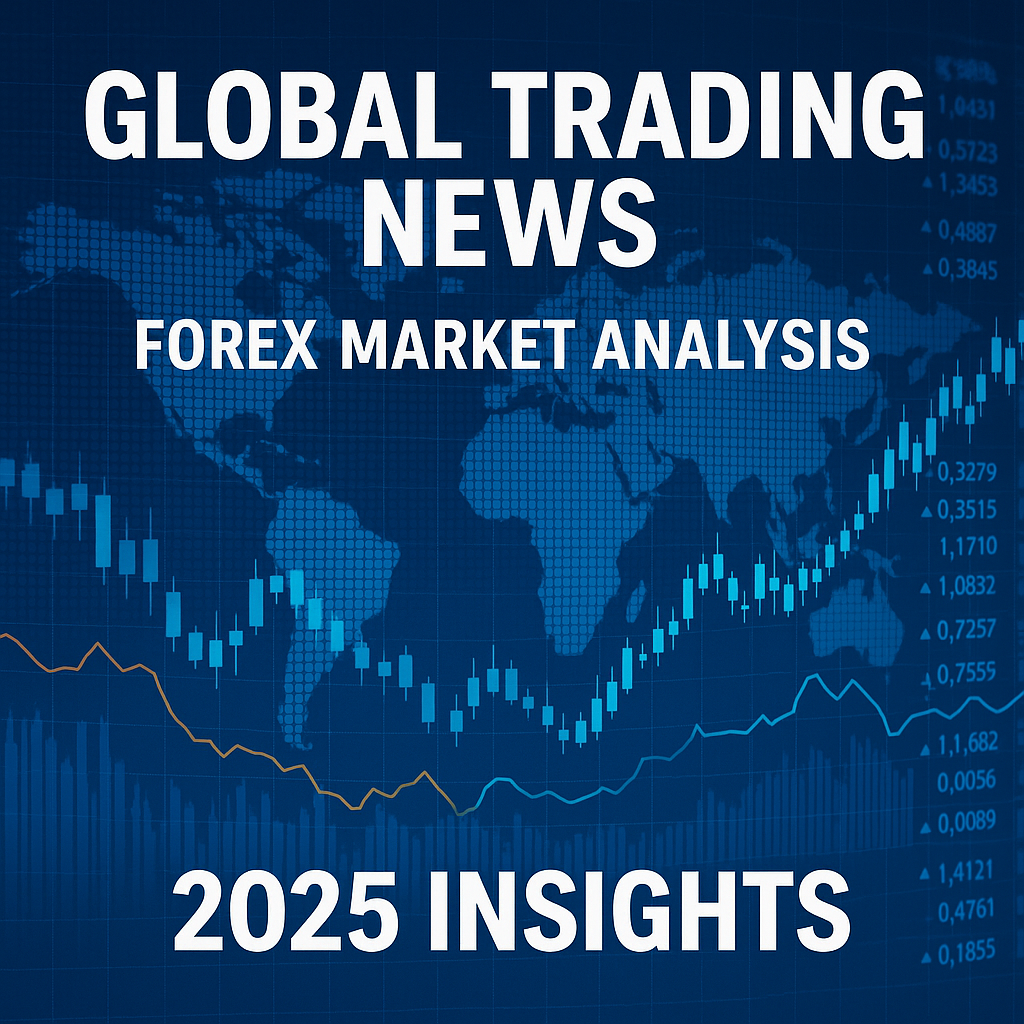Introduction
The global forex market continues to be the largest and most liquid financial market in the world. With daily volumes surpassing $7 trillion, the forex market operates 24 hours a day across major financial hubs like London, New York, Tokyo, and Sydney. In 2025, several factors including inflation trends, geopolitical tensions, monetary policy shifts, and advancements in trading technology are influencing the movement of currencies. Understanding both technical and fundamental aspects of trading has become more crucial than ever for traders seeking consistent profitability. In this detailed article, we explore the latest global trading news, perform a deep technical and fundamental analysis, and provide expert insights into crafting winning forex strategies.
Global Economic Backdrop And Forex Impact
The global economy in 2025 presents a mixed picture. Inflationary pressures have eased somewhat compared to the peaks of 2023, but they remain above target levels for many central banks. The Federal Reserve, the European Central Bank, and the Bank of Japan are navigating complex environments where maintaining economic growth while controlling inflation is a tightrope act. The US dollar remains strong but volatile as markets react to shifting interest rate projections. Meanwhile, emerging markets face challenges due to debt pressures and fluctuating commodity prices. This backdrop creates diverse trading opportunities in major, minor, and exotic currency pairs. Traders must stay updated on macroeconomic indicators like GDP growth, inflation rates, employment figures, and central bank communications to anticipate currency movements.
Technical Analysis: Patterns Shaping Forex Trends
Technical analysis remains a cornerstone for short-term and medium-term forex traders. In 2025, several classic chart patterns and technical indicators continue to dominate trading strategies. The head and shoulders pattern is frequently observed across USD pairs, suggesting potential reversals at critical price levels. Moving averages, particularly the 50-day and 200-day, are key in determining overall trend directions. Crossovers between these averages, known as golden crosses and death crosses, provide strong trading signals.
Additionally, the Relative Strength Index (RSI) and MACD (Moving Average Convergence Divergence) help traders identify overbought and oversold conditions, enabling strategic entries and exits. Fibonacci retracement levels, especially the 38.2 percent and 61.8 percent points, serve as important support and resistance levels in trending markets. It is crucial for traders to combine multiple indicators to filter out false signals and enhance their technical analysis precision.
Fundamental Analysis: News Events Driving Volatility
Fundamental analysis focuses on the economic, political, and financial news that drives currency values. Key events like central bank meetings, interest rate announcements, and geopolitical developments heavily influence forex markets. In 2025, the forex market has witnessed significant moves based on US employment reports, European inflation data, and shifts in Chinese economic policy. Central bank decisions, especially those related to quantitative tightening or easing, create major volatility spikes.
Traders closely monitor Federal Reserve speeches, ECB meeting minutes, and monetary policy updates from the Bank of England and Reserve Bank of Australia. Furthermore, political developments such as elections, trade agreements, and military conflicts can dramatically alter risk sentiment, causing safe-haven currencies like the US dollar, Japanese yen, and Swiss franc to strengthen. Staying informed through reliable news sources and economic calendars is essential for integrating fundamental factors into forex trading strategies.
Major Currency Pairs Analysis: EUR/USD, GBP/USD, USD/JPY
The EUR/USD pair remains the most traded currency pair globally, and in 2025, it has experienced a complex interplay between eurozone recovery efforts and US monetary policy. A stronger European economic outlook tends to support the euro, but lingering recession risks and energy dependency issues create downside pressure. Traders should watch for key support at 1.0600 and resistance at 1.1200 based on technical charts.
GBP/USD trading hinges on the Bank of England’s stance regarding inflation control versus economic support. After facing a turbulent 2024, the British pound shows relative stability, but remains sensitive to domestic political shifts and Brexit-related negotiations. Technical traders monitor the 1.2800 support level and the 1.3400 resistance zone.
USD/JPY has seen significant volatility, primarily due to the contrasting policies of the Fed and the Bank of Japan. The yen, traditionally a safe-haven asset, has weakened amid Japan’s ultra-loose monetary policy, but bouts of global risk aversion periodically strengthen it. Important technical zones include support around 145.00 and resistance near 152.00.
Emerging Market Currencies And Forex Opportunities
Emerging market currencies present both opportunities and risks for forex traders. In 2025, the Mexican peso (MXN), South African rand (ZAR), and Turkish lira (TRY) have exhibited heightened volatility. High interest rates in these countries can attract carry traders seeking higher returns, but political instability and external debt vulnerabilities pose significant risks.
For instance, the South African rand remains heavily influenced by commodity price fluctuations and domestic political dynamics. Traders venturing into emerging market currencies must account for wider spreads, lower liquidity, and increased geopolitical risks. Risk management strategies like stop-loss orders and position sizing become even more critical when trading these pairs.
Central Bank Policies: Shaping Currency Flows
Central banks are the primary drivers of forex market movements through their monetary policies. In 2025, central banks have adopted divergent strategies based on domestic economic conditions. The Federal Reserve remains cautious, balancing between maintaining economic expansion and avoiding inflation resurgence. The ECB is gradually winding down its asset purchase programs while keeping rates moderately restrictive.
The Bank of Japan continues its accommodative stance, leading to persistent weakness in the yen. Traders must understand not just headline interest rates but also forward guidance, inflation targets, and employment mandates. Analyzing central bank minutes and speeches helps anticipate policy shifts, giving traders an edge in positioning for medium and long-term trades.
Risk Management In Volatile Markets
Risk management is non-negotiable for forex traders aiming for long-term success. Volatility in 2025 remains elevated, driven by sudden economic releases and geopolitical surprises. Traders should adopt strict risk-to-reward ratios, ideally risking no more than 1 to 2 percent of account equity per trade. Utilizing stop-loss and take-profit orders ensures that emotional decisions do not derail trading plans. Leverage, while offering potential for amplified gains, also magnifies losses. Prudent traders use conservative leverage ratios and regularly reassess their positions based on evolving market conditions. Moreover, diversifying trading portfolios across multiple currency pairs reduces exposure to single-market risks.
Trading Strategies For 2025: Blending Technical And Fundamental Approaches
Successful forex trading in 2025 requires blending both technical and fundamental analysis into cohesive strategies. Swing trading remains popular, with traders capturing medium-term trends based on macroeconomic themes. Scalping strategies thrive in high-volatility environments, capitalizing on small price movements within major news event windows. Algorithmic trading and the use of trading bots are growing, leveraging AI-driven models to execute trades based on predefined rules. However, manual oversight remains critical, as algorithms can misinterpret abnormal market behavior. Traders should backtest their strategies extensively and continuously refine their systems based on real-time market feedback.
Psychology Of Forex Trading: Mastering Emotions
Beyond technical skills and market knowledge, trading psychology plays a pivotal role in forex success. Emotions like fear, greed, and impatience often lead to poor trading decisions. In 2025’s fast-paced environment, maintaining discipline and adhering to trading plans is more important than ever. Developing a resilient mindset helps traders endure inevitable losing streaks and avoid revenge trading. Journaling trades, setting realistic goals, and practicing mindfulness techniques are effective ways to enhance emotional control. Ultimately, the ability to stay objective and patient often separates consistently profitable traders from those who struggle.
Technological Innovations Reshaping Forex Trading
Technology continues to reshape the forex trading landscape. In 2025, advanced trading platforms offer real-time analytics, automated strategy execution, and seamless integration with economic news feeds. Mobile trading apps allow traders to manage positions on the go, increasing flexibility and responsiveness. AI and machine learning are increasingly embedded in trading algorithms, improving pattern recognition and predictive analytics. Blockchain technology is also beginning to influence forex transactions by offering faster settlement times and enhanced transparency. Traders who stay abreast of technological advancements and adapt their trading processes accordingly gain a significant competitive advantage.
Conclusion
The forex market in 2025 presents abundant opportunities but also heightened risks. A combination of thorough technical analysis, deep fundamental understanding, disciplined risk management, and emotional resilience is essential for success. Traders must stay informed through continuous market research and remain adaptable to the ever-evolving financial landscape. By integrating global trading news insights with sound market analysis techniques, forex traders can build sustainable strategies and achieve their trading objectives in this dynamic environment.




